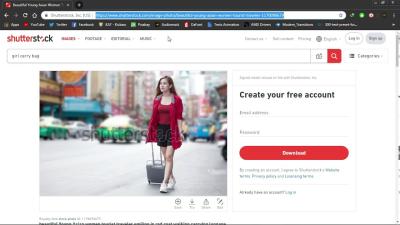Have you ever wondered how Shutterstock keeps tabs on which images are popular? As one of the leading stock photo platforms, Shutterstock needs to understand what kinds of images are catching users’ eyes. That’s where their tracking system comes into play. It helps creators, buyers, and
Methods Shutterstock Uses to Monitor Image Views

Shutterstock employs a variety of methods to keep an eye on how many times an image is viewed. Here’s a breakdown of the main techniques:
- Click Tracking: Every time someone clicks on an image to view it, the platform logs this action. This helps determine the image’s popularity based on user interest.
- Page View Analytics: Shutterstock tracks how many times an image’s page is loaded. If an image’s page gets a lot of visits, it indicates high interest, even if users don’t download it.
- Engagement Metrics: Beyond just views, they analyze how users interact with images—like how long they stay on an image page or if they add images to their collections.
- Unique Visitors: The platform differentiates between total views and unique visitors. This way, they understand whether a single user is repeatedly viewing an image or if many different users are interested.
- Device and Location Data: Shutterstock also considers the device type (mobile vs. desktop) and geographic data to better understand viewing patterns and preferences across different regions.
All these methods work together to give Shutterstock a comprehensive picture of an image’s performance. They help creators see what resonates with audiences and enable Shutterstock to showcase trending images. This continuous tracking ensures that the most popular and relevant images get the attention they deserve, ultimately making the platform more engaging for everyone involved.
The Importance of Tracking Image Views for Creators and Buyers
Understanding how many times an image has been viewed isn’t just a number — it’s a window into how your work is resonating with people. For creators, tracking image views provides valuable insights into which images attract the most attention. This information can help you identify your popular styles, themes, or subjects, guiding your future projects and growth strategies. If a particular type of image consistently garners high views, it might be a good idea to create more similar content.
For buyers or clients browsing Shutterstock, view data can indicate the popularity or relevance of an image. If an image has been viewed many times, it suggests that many people find it useful or appealing. This can be a helpful sign when choosing images for projects, campaigns, or publications — a highly viewed image might be more likely to catch viewers’ attention and generate engagement.
Additionally, tracking views helps creators stay motivated. Seeing that your work is being noticed and appreciated can boost confidence and inspire you to keep creating. On the flip side, if an image isn’t getting many views, it might be time to tweak your approach — maybe adjust the keywords, improve the description, or experiment with different styles.
In essence, view data is a powerful feedback loop. It tells creators what’s working, helps buyers make smarter choices, and ultimately creates a more dynamic marketplace where quality and relevance matter. Whether you’re just starting out or are a seasoned professional, keeping an eye on image views can significantly impact your success on Shutterstock.
How View Data Influences Image Rankings and Visibility
You might wonder, “How does the number of views actually impact how my images are displayed on Shutterstock?” Well, Shutterstock uses view data as one of several factors in its ranking algorithms. Think of it like a popularity contest — images that attract more views often get more visibility in search results and on category pages.
Here’s how it works in a nutshell:
- Higher View Counts = Better Rankings: Images that receive a lot of views tend to move higher in search results because Shutterstock’s goal is to showcase images that are engaging and relevant. When your image is viewed often, it signals to the platform that users find it appealing.
- Boosted Visibility: Top-performing images are more likely to appear on the first page of search results, making them more accessible to potential buyers. This increased exposure can lead to even more views, creating a positive feedback loop.
- Algorithmic Factors: Views are just one piece of the puzzle. Shutterstock also considers elements like click-through rates, saves, downloads, relevance to keywords, and image quality. But views often act as a key indicator of an image’s popularity.
For creators, this means that actively promoting your images, choosing trending topics, and optimizing keywords can help boost views and improve your image rankings. For buyers, it’s a way to gauge which images are currently trending or widely appreciated.
Ultimately, understanding this relationship helps everyone involved — creators can strategize better, and buyers can find high-quality, popular images more easily. It’s all about creating a vibrant ecosystem where quality content gets the attention it deserves, and view data plays a crucial role in that process.
Privacy and Data Security in Shutterstock’s Tracking Processes
When you hear about companies tracking how images are viewed, it’s natural to wonder, “What does that mean for my privacy?” At Shutterstock, they take privacy and data security seriously. They want to understand user engagement without compromising the privacy of individual viewers. So, how do they do it?
Shutterstock uses sophisticated tracking methods that focus on aggregate data rather than identifying individual users. This means they collect information like the number of views an image receives, the geographic location of viewers, and the device types used—but they don’t track who specifically is viewing the images. This approach helps them gain insights into trends and popular content without infringing on personal privacy.
To ensure data security, Shutterstock employs industry-standard encryption protocols. All data transmitted between your device and their servers is encrypted to prevent unauthorized access. Additionally, they follow strict access controls internally, meaning only authorized personnel can handle sensitive data, and even then, only the data necessary for their analysis.
Moreover, Shutterstock complies with global privacy regulations such as GDPR in Europe and CCPA in California. These laws require transparency about data collection practices and give users rights over their data, including access and deletion options. Shutterstock provides clear privacy policies explaining what data they collect, how they use it, and how users can manage their privacy preferences.
In essence, Shutterstock’s tracking system is designed to maintain a balance: gathering enough data to improve their platform and understand content performance, while respecting user privacy and ensuring data security. So, as a user or contributor, you can feel reassured that your privacy is protected, and your data is handled responsibly.
Conclusion: The Impact of View Tracking on Stock Image Market
Understanding how Shutterstock tracks image views gives us a peek into the bigger picture of the stock image industry. View tracking isn’t just about counting clicks; it’s a powerful tool that shapes how content is created, marketed, and valued.
For contributors, knowing that their images are being monitored helps them understand what kind of content resonates with audiences. This insight can guide photographers and designers to focus on trending themes, improve their work, and ultimately increase their sales. It’s like having a feedback loop that helps creators refine their craft based on real user interest.
On the business side, view data allows Shutterstock to identify popular subjects and emerging trends. This information influences their curation, marketing strategies, and even the development of new features on their platform. For buyers, it means they’re more likely to find images that are currently in demand, making their search more efficient and tailored to current market needs.
However, it’s also important to recognize the broader implications. As view tracking becomes more sophisticated, questions about data privacy and ethics come into play. The industry must continue to prioritize transparency and responsible data handling to maintain trust among users and contributors alike.
In the end, view tracking is a vital part of the modern stock image ecosystem. It helps ensure that the platform remains dynamic, relevant, and fair for everyone involved. As technology evolves, so will the ways companies like Shutterstock use data—always aiming to improve the experience while respecting privacy. Understanding this process empowers both creators and consumers to navigate the stock image market confidently and responsibly.


